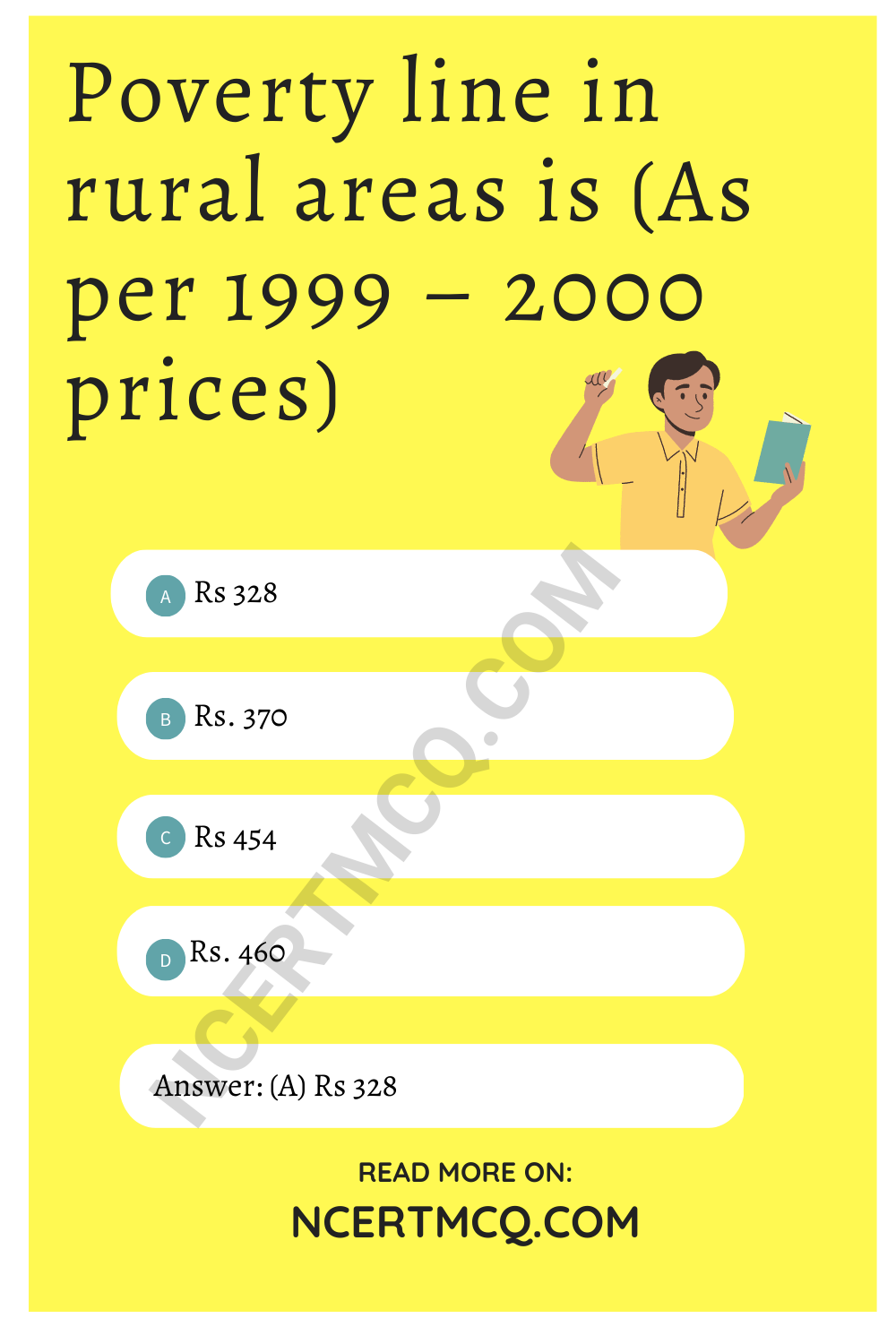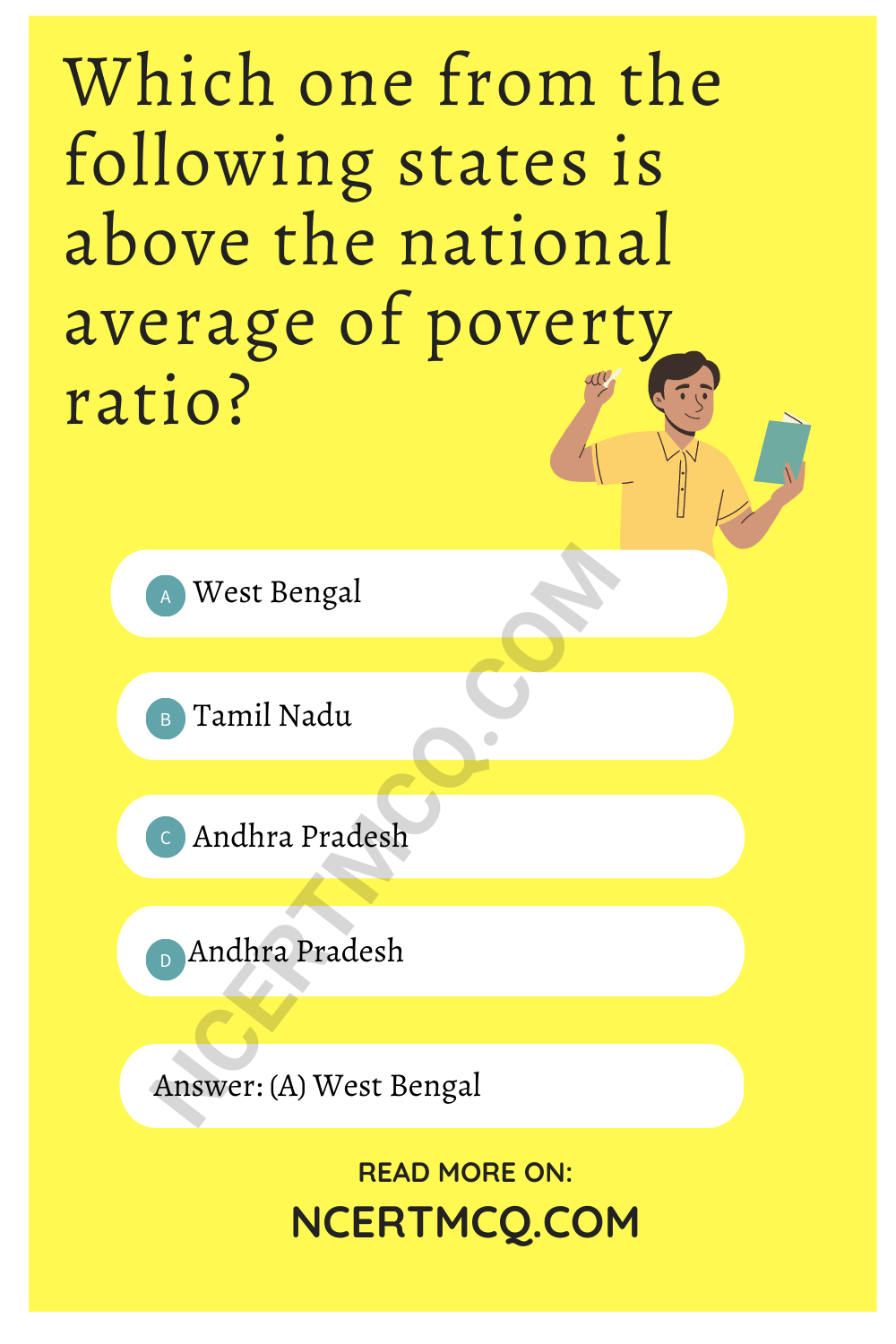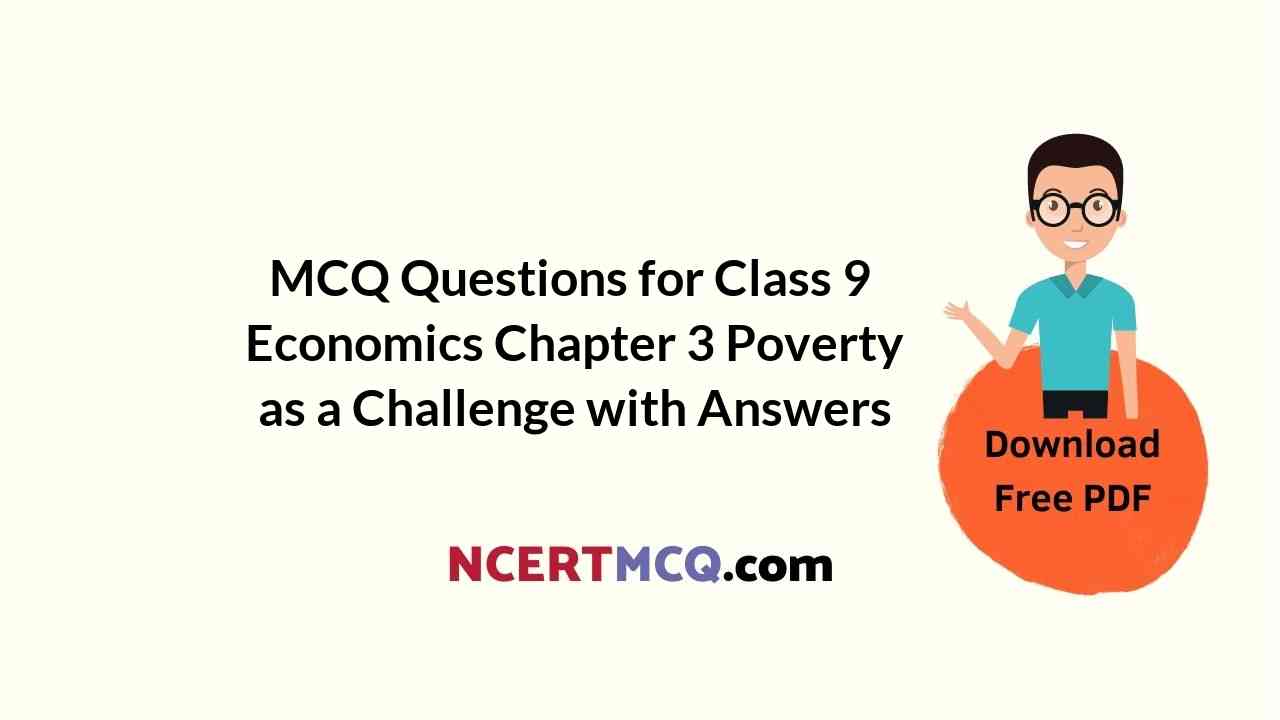Check the below Online Education NCERT MCQ Questions for Class 9 Economics Chapter 3 Poverty as a Challenge with Answers Pdf free download. MCQ Questions for Class 9 Social Science with Answers were prepared based on the latest exam pattern. We have Provided Poverty as a Challenge Class 9 Economics MCQs Questions with Answers to help students understand the concept very well. https://ncertmcq.com/mcq-questions-for-class-9-social-science-with-answers/
Class 9 Social Science Economics Chapter 3 MCQ With Answers
Economics Class 9 Chapter 3 MCQs On Poverty as a Challenge
Choose the correct option:
Poverty As A Challenge Class 9 MCQ Question 1.
NFWP is stand for:
(a) National Federation for Work and Progress
(b) National Forest for Wildlife Protection
(c) National Food and Wheat Processing
(d) National Food for Work Programme
Answer
Answer: (d) National Food for Work Programme
Class 9 Economics Chapter 3 MCQ With Answers Question 2.
How many people in India live below the poverty line?
(a) 30 crores
(b) 26 crores
(c) 28 crores
(d) 24 crores
Answer
Answer: (b) 26 crores
Poverty As A Challenge MCQ Question 3.
Which social group is most vulnerable to poverty in India?
(a) Scheduled castes
(b) Scheduled tribes
(c) Casual labourers
(d) All the above
Answer
Answer: (d) All the above
Poverty As Challenge Class 9 MCQ Question 4.
Poverty line in rural areas is (As per 1999 – 2000 prices)
(a) Rs 328
(b) Rs. 370
(c) Rs 454
(d) Rs. 460
Answer
Answer: (a) Rs 328

Class 9 Poverty As A Challenge MCQ Question 5.
What is the poverty ratio in the state of Orissa?
(a) 50%
(b) 47%
(c) 60%
(d) 57%
Answer
Answer: (b) 47%
MCQ Of Poverty As A Challenge Question 6.
In which state have the land reform measures helped to reduce poverty?
(a) Tamil Nadu
(b) Punjab
(c) West Bengal
(d) Kerala
Answer
Answer: (c) West Bengal
Ch 3 Economics Class 9 MCQ Question 7.
In which state is the public distribution system responsible for the reduction in poverty?
(a) Andhra Pradesh
(b) Tamil Nadu
(c) Both (a) and (b)
(d) None of the above
Answer
Answer: (c) Both (a) and (b)
MCQ Questions For Class 9 Economics Chapter 3 Question 8.
Which of the following is responsible for high poverty rates?
(a) Huge income inequalities
(b) Unequal distribution of land
(c) Lack of effective implementation of land reforms
(d) All the above
Answer
Answer: (d) All the above
Economics Class 9 Chapter 3 MCQ Question 9.
Nutritional level of food energy is expressed in the form of
(a) calories per day
(b) wheat consumption
(c) rice consumption per day
(d) none of the above
Answer
Answer: (a) calories per day
Poverty MCQ Class 9 Question 10.
Poverty ratio in India as compared to Pakistan is
(a) same
(b) half
(c) two times
(d) two and a half times
Answer
Answer: (c) two times
Poverty As Challenge MCQ Question 11.
Which one from the following is considered as poor?
(a) A rich landlord
(b) A businessman
(c) A landless labourer
(d) A teacher
Answer
Answer: (c) A landless labourer
Poverty Class 9 MCQ Question 12.
Which state has the largest percentage of poors in India?
(a) Bihar
(b) Orissa
(c) Kerala
(d) Punjab
Answer
Answer: (b) Orissa
Class 9 Eco Ch 3 MCQ Question 13.
Who advocated that India would be truly independent only when the poorest of its people become free of human suffering ?
(a) Mahatma Gandhi
(b) Indira Gandhi
(c) Jawahar lal Nehru
(d) Subhash Chandra Bose
Answer
Answer: (a) Mahatma Gandhi
Economics Chapter 3 Class 9 MCQ Question 14.
Who do not come under the category of urban poor?
(a) The casual workers
(b) The unemployed
(c) The shopkeepe
(d) Rickshawpullers
Answer
Answer: (c) The shopkeepe
Class 9 Economics Ch 3 MCQ Question 15.
Which scheme was started in 1993 to create self-employment opportunities for educated unemployed youth in rural areas and small towns?
(a) Prime Minister Rojgar Yojana
(b) National Rural Employment Guarantee Act
(c) Rural Employment Generation Programme
(d) Swarnajayanti Gram Swarojgar Yojana
Answer
Answer: (a) Prime Minister Rojgar Yojana
MCQ Of Poverty As A Challenge Class 9 Question 16.
Which one of the social groups is vulnerable to poverty?
(a) Scheduled caste
(b) Urban casual labour
(c) Rural agricultural households
(d) All the above
Answer
Answer: (d) All the above
Ncert Class 9 Economics Chapter 3 MCQ Question 17.
Which one are not the major causes of income inequality in India?
(a) Unequal distribution of land
(b) Lack of fertile land
(c) Gap between rich and the poor
(d) Increase in population
Answer
Answer: (b) Lack of fertile land
MCQ Of Chapter 3 Economics Class 9 Question 18.
The calorie requirement is higher in the rural areas because:
(a) they do not enjoy as much as people in the urban areas.
(b) food items are expensive.
(c) they are engaged in mental work.
(d) people are engaged in physical labour.
Answer
Answer: (d) people are engaged in physical labour.
Class 9th Economics Chapter 3 MCQ Question 19.
Which of the following is not a valid reason for the poverty alleviation programme in India?
(a) Lack of proper implementation
(b) Lack of right targeting
(c) Corruption at the highest level
(d) Overlapping of schemes
Answer
Answer: (c) Corruption at the highest level
Chapter 3 Economics Class 9 MCQ Question 20.
Which one from the following states is above the national average of poverty ratio?
(a) West Bengal
(b) Tamil Nadu
(c) Andhra Pradesh
(d) Karnataka
Answer
Answer: (a) West Bengal

We hope the given NCERT MCQ Questions for Class 9 Economics Chapter 3 Poverty as a Challenge with Answers Pdf free download will help you. If you have any queries regarding Poverty as a Challenge CBSE Class 9 Economics MCQs Multiple Choice Questions with Answers, drop a comment below and we will get back to you soon.
Class 9 Social Science Economics MCQ:
